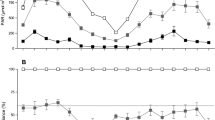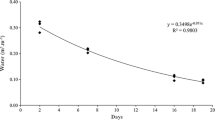Abstract
In a dense stand, individuals compete with each other for resources, especially for light. Light availability decreases with increasing depth in the canopy, thus light competition becoming stronger with time in the vegetative phase. In the reproductive phase, on the other hand, leaves start senescing, and the light environment, particularly of smaller individuals, will be improved. To study the effect of change in light climate on reproduction of individuals, we established an experimental stand of an annual, Xanthium canadense, and assessed temporal changes in whole plant photosynthesis through the reproductive phase with particular reference to light availability of individuals. At flowering, 83% of individuals were still alive, but only 27% survived to set seeds. Most of the individuals that died in the reproductive phase were smaller than those that produced seeds. Individuals that died at the early stage of the reproductive phase had a lower leaf to stem mass ratio, suggesting that the fate of individuals was determined partly by the pattern of biomass allocation in this period. At the early stage of the reproductive phase, leaf area index (LAI) of the stand was high and larger individuals had higher whole plant photosynthesis than smaller individuals. Although light availability at later stages was improved with reduction in LAI, whole plant photosynthesis was very low in all individuals due to a lower light use efficiency, which was caused by a decrease in photosynthetic N use efficiency. We conclude that light competition was still strong at the early stage of the reproductive phase and that later improvement of light availability did not ameliorate the photosynthesis of smaller individuals.






Similar content being viewed by others
References
Aikman DP, Watkinson AR (1980) A model for growth and self-thinning in even-aged monocultures of plants. Ann Bot 45:419–427
Anten NPR, Schieving F, Werger MJA (1995) Patterns of light and nitrogen distribution in relation to whole canopy carbon gain in C3 and C4 mono- and dicotyledonous species. Oecologia 101:504–513
Anten NPR, Werger MJA (1996) Canopy structure and nitrogen distribution in dominant and subordinate plants in a dense stand of Amaranthus dubius L. with a size hierarchy of individuals. Oecologia 105:30–37
Anten NPR (1997) Modelling canopy photosynthesis using parameters determined from simple non-destructive measurements. Ecol Res 12:77–88
Anten NPR, Miyazawa K, Hikosaka K, Nagashima H, Hirose T (1998) Leaf nitrogen distribution in relation to leaf age and photon flux density in dominant and subordinate plants in dense stands of a dicotyledonous herb. Oecologia 113:314–324
Anten NPR, Hirose T (2001) Limitations on photosynthesis of competing individuals in stands and consequences for canopy structure. Oecologia 129:186–196
Ballaré CL, Scopel AL, Sánchez RA (1990) Far-red radiation reflected from adjacent leaves: an early signal of competition in plant canopies. Science 247:329–332
Bazzaz FA (1996) Plants in changing environments. Cambridge University Press, London
Benjamin LR, Hardwick RC (1986) Sources of variation and measures of variability in even-aged stands of plants. Ann Bot 58:757–778
Berry JA, Björkman O (1980) Photosynthetic response and adaptation to temperature in higher plants. Annu Rev Plant Physiol 31:491–543
Borjigidai A, Hikosaka K, Hirose T, Hasegawa T, Okada M, Kobayashi K (2006) Seasonal changes in temperature dependence of photosynthetic rate in rice under a free-air CO2. Ann Bot 97:549–557
Chiariello N, Roughgarden J (1984) Storage allocation in seasonal races of an annual plant: optimal versus actual allocation. Ecology 65:1290–1301
Egli P, Schmid B (1999) Relationships between leaf nitrogen and limitations of photosynthesis in canopies of Solidago altissima. Acta Oecol 20:559–570
Ford ED (1975) Competition and stand structure in some even-aged plant monocultures. J Ecol 63:311–333
Goudriaan J (1977) Crop micrometeorology: a simulation study, simulation monographs. Pudoc, Wageningen
Hara T (1984a) A stochastic model and the moment dynamics of the growth and size destribution in plant populations. J Theor Biol 109:173–190
Hara T (1984b) Dynamics of stand structure in plant monocultures. J Theor Biol 110:223–239
Hara T (1986) Growth of individuals in plant populations. Ann Bot 57:55–68
Hasegawa T, Horie T (1996) Rice leaf photosynthesis as a function of nitrogen content and crop developmental stage. Jpn J Crop Sci 65:553–554
Hikosaka K (1996) Effects of leaf age, nitrogen nutrition and photon flux density on the organization of the photosynthetic apparatus in leaves of a vine (Ipomoea tricolor Cav.) grown horizontally to avoid mutual shading of leaves. Planta 198:144–150
Hikosaka K, Hanba YT, Hirose T, Terashima I (1998) Photosynthetic nitrogen-use efficiency in woody and herbaceous plants. Funct Ecol 12:896–905
Hikosaka K, Sudoh S, Hirose T (1999) Light acquisition and use of individuals competing in a dense stand of an annual herb, Xanthium canadence. Oecologia 118:388–396
Hikosaka K, Hirose T (2001) Nitrogen uptake and use of competing individuals in a Xanthium canadense stand. Oecologia 126:174–181
Hikosaka K, Yamano T, Nagashima H, Hirose T (2003) Light-acquisition and use of individuals as influenced by elevated CO2 in even-aged monospecific stands of Chenopodium album. Funct Ecol 17:786–795
Hikosaka K (2004) Interspecific difference in the photosynthesis-nitrogen relationship: patterns, physiological causes, and ecological importance. J Plant Res 117:481–494
Hikosaka K, Ishikawa K, Borjigidai A, Muller O, Onoda Y (2006) Temperature acclimation of photosynthesis: mechanisms involved in the changes in temperature dependence of photosynthetic rate. J Exp Bot 57:291–302
Hirose T, Werger MJA (1987) Maximizing daily canopy photosynthesis with respect to the leaf nitrogen allocation pattern in the canopy. Oecologia 72:520–526
Hirose T, Werger MJA (1995) Canopy structure and photon flux partitioning among species in a herbaceous plant community. Ecology 76:466–474
Hirose T, Kinugasa T, Shitaka Y (2005) Time of flowering, costs of reproduction, and reproductive output in annuals. In: Reekie E, Bazzaz FA (eds) Reproductive allocation in plants. Elsevier, San Diego, pp 159–188
King D, Roughgarden J (1983) Energy allocation patterns of the California grassland annuals Plantago erecta and Clarkia rubicunda. Ecology 64:16–24
Kinugasa T, Hikosaka K, Hirose T (2003) Reproductive allocation of an annual, Xanthium canadense, at an elevated carbon dioxide concentration. Oecologia 137:1–9
Koyama H, Kira T (1956) Intraspecific competition among higher plants. VIII. Frequency distribution of individual plant weight as affected by the interaction between plants. J Inst Polytech Osaka City Univ D7:73–94
Mae T, Ohira K (1982) Relation between leaf age and nitrogen incorporation in the leaf of the rice plant (Oryza sativa L.). Plant Cell Physiol 23:1019–1024
Makino A, Mae T, Ohara K (1983) Photosynthesis and ribulose 1,5-bisphosphate carboxylase in rice leaves. Plant Physiol 73:1002–1007
Mogan DC, Smith H (1979) A systematic relationship between phytochrome-controlled development and species habitat for plants grown in simulated natural radiation. Planta 145:253–259
Mohler CL, Marks PL, Sprugel DG (1978) Stand structure and allometry of trees during self-thinning of pure stands. J Ecol 66:599–614
Monsi M, Saeki T (1953) Über den Lichtfaktor in den Pflanzengesellschaften und seine Bedeutung für die Stoffproduktion. Jpn J Bot 14:22–52
Monteith JL (1977) Climate and the efficiency of crop production in Britain. Phil Trans R Soc Lond B 281:277–294
Nagashima H, Terashima I, Katoh S (1995) Effects of plant density on frequency distributions of plant height in Chenopodium album stands: analysis based on continuous monitoring of height-growth of individual plants. Ann Bot 75:173–180
Nagashima H, Terashima I (1995) Relationships between height, diameter and weight distributions of Chenopodium album plants in stands: effects of dimension and allometry. Ann Bot 75:181–188
Nagashima H (1999) The processes of height-rank determination among individuals and neighbourhood effects in Chenopodium alum L. stands. Ann Bot 83:501–507
Naylor REL (1976) Changes in the structure of plant populations. J Appl Ecol 13:513–521
Ohsumi A, Hamasaki A, Nakagawa H, Yoshida H, Shiraiwa T, Horie T. (2007) A model explaining genotypic and ontogenetic variation of leaf photosynthetic rate in rice (Oryza sativa) based on leaf nitrogen content and stomatal conductance. Ann Bot 99:265–273
Oikawa S, Hikosaka K, Hirose T (2006) Leaf lifespan and lifetime carbon gain of individual leaves in a stand of an annual herb, Xanthium canadense. New Phytol 172:104–116
Pettigrew WT, McCarty JC, Vaughn KC (2000) Leaf senescence-like characteristics contribute to cotton’s premature photosynthetic decline. Photosynth Res 65:187–195
Reekie EG (1999) Resource allocation, trade-offs, and reproductive effort in plants. In: Vuorisalo TO, Nutikainen PK (eds) Life history evolution in plants. Kluwer, Dordrecht
Sadras VO, Echarte LE, Andrade FH (2000) Profiles of leaf senescence during reproductive growth of sunflower and maize. Ann Bot 85:187–195
Schieving F, Werger MJA, Hirose T (1992) Canopy structure, nitrogen distribution and whole canopy photosynthetic carbon gain in growing and flowering stands of tall herbs. Vegetatio 102:173–181
Shitaka Y, Hirose T (1998) Effects of shift in flowering on the reproductive output of Xanthium canadense in a seasonal environment. Oecologia 114:361–367
Sokal RR, Rohlf FJ (1985) Biometry, 2nd edn. Freeman, New York
Solbrig OT (1981) Studies on the population biology of the genus Viola. II. The effect of plant size on fitness in Viola sororia. Evolution 35:1080–1093
Sugiyama H, Hirose T (1991) Growth schedule of Xanthium canadense: does it optimize the timing of reproduction? Oecologia 88:55–60
Weiner J, Thomas SC (1986) Size variability and competition in plant monocultures. Oikos 47:211–222
Weiner J (1985) Size hierarchies in experimental population of annual plants. Ecology 66:743–752
Weiner J (1990) Asymmetric competition in plant populations. Trend Ecol Evol 5:360–364
Werner PA, Caswell H (1977) Population growth rates and age versus stage-distribution models for teasel (Dipsacus sylvestris Huds.). Ecology 58:1103–1111
White J, Harper JL (1970) Correlated changes in plant size and number in plant populations. J Ecol 58:467–485
Yasumura Y, Hikosaka K, Hirose T (2006) Seasonal changes in photosynthesis, nitrogen content and nitrogen partitioning in Lindera umbellata leaves grown under high or low irradiance. Tree Physiol 26:1315–1323
Yasumura Y, Hikosaka K, Hirose T (2007) Nitrogen resorption and protein degradation during leaf senescence in Chenopodium album grown in different light and nitrogen conditions. Funct Plant Biol 34:409–417
Acknowledgements
We thank K. Akechi for helpful suggestions. This study was supported in part by KAKENHI.
Author information
Authors and Affiliations
Corresponding author
Additional information
Communicated by Fernando Valladares.
Electronic supplementary material
Below is the link to the electronic supplementary material.
Rights and permissions
About this article
Cite this article
Matsumoto, Y., Oikawa, S., Yasumura, Y. et al. Reproductive yield of individuals competing for light in a dense stand of an annual, Xanthium canadense . Oecologia 157, 185–195 (2008). https://doi.org/10.1007/s00442-008-1062-6
Received:
Accepted:
Published:
Issue Date:
DOI: https://doi.org/10.1007/s00442-008-1062-6




